Is It Easy to Roast Coffee Properly?
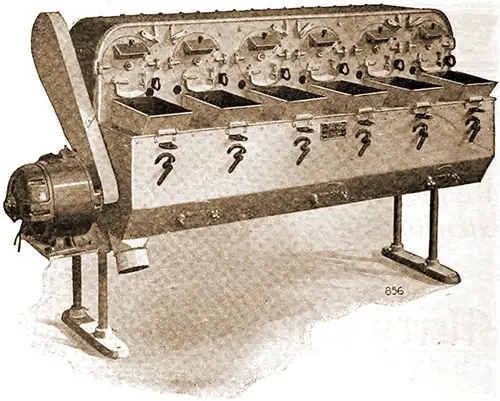
The Latest and Best Sample Roaster. This New 1921 Model "Monitor" Coffee Sample Roaster Has Been Produced To Fill Definite Requirements Heretofore Not Met To the Point of Highest Efficiency. The Spice Mill, December 1921. GGA Image ID # 1634741bb8
Perhaps, the chief difficulty in trying to answer this question is knowing just what proper coffee roasting is.
Coffee is a perplexing study. Perhaps a good deal of the interest in it results from the very fact that it seems impossible to discover precisely what the aromatic appeal of coffee consists of or depends upon.
The market value of any lot of green coffee is based on the cup value, which it is believed, it will have after roasting in the estimation of a certain class of coffee drinkers.
As roasting is the operation on which all the coffee's final value depends, it seems worthwhile inquiring whether more intelligent attention might not be given to the possibilities of getting improved roasting results.
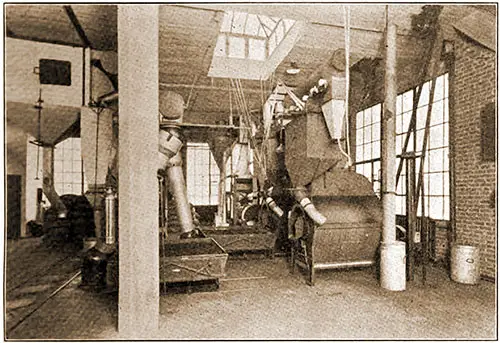
The Roasting Room Has Two 500 LB. Jubilee Roasters With Flexarm Coolers, Etc., and Complete Machinery for Milling and Mixing Green Coffee. The Spice Mill, April 1921. GGA Image ID# 1634b6764d
There is much talk at present about the need for further chemical investigation of the coffee bean, and continuous efforts have certainly been made to devise improved coffee roasting machinery.
From a purely mechanical standpoint, the machinery improvements have been important, particularly as regards economy in producing large quantities of roasted coffee. But nothing in the nature of an automatic roasting machine has been built successfully, and it is still the man who operates the machine who must decide when the batch of coffee has been roasted to the proper point.
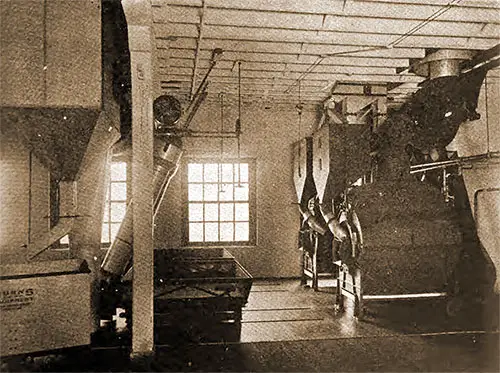
Morton Coffee Co. Roasting Equipment; 4th Story Looking South, Toward Front of Building. The Spice Mill, Jun 1921. GGA Image ID # 1635085fcb
The most perfect machine merely allows the skilled operator to use his skill with more sureness; that is, permits him to achieve more easily the development of the coffee which he, and not the machine, is responsible for.
The chemical investigations, so far, have given practically no results which enable experienced machinery people to devise better roasters or allow expert operators to turn out superior work.
It seems, therefore, looking at the question as it stands and has stood for years, that the least consideration has probably been given all along to the most important element in the problem, which is the individual from whose skill a satisfactory development of the coffee is expected.
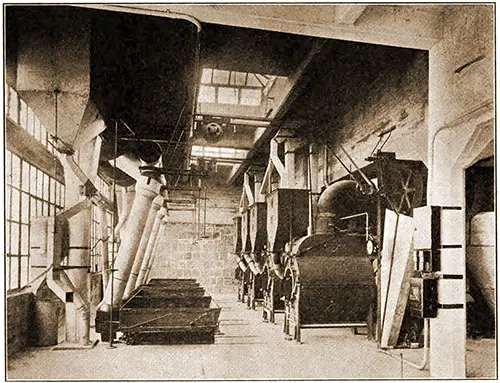
New Coffee Roasting Plant of Great Atlantic & Pacific Tea Co. in Somerville, Mass. The Spice Mill, April 1921. GGA Image ID # 163524a017
This does not mean that the average roasting establishment fails to look upon the roasterman as a highly important person. It means merely that, the importance of the roasterman being recognized, very little consistent effort is directed toward making sure that he is the best person obtainable for the job or that he is given such treatment as will enable him to perform the best work of which he is capable.
Ability to roast coffee well seems to have considerable relation to the size of the batch. A bright boy soon learns how to handle a sample roaster and turn out the coffee to the complete satisfaction of keen judges who are deciding big deals on the basis of the sample roasts.
The same boy might prove unable to turn out good roasts with a small commercial machine, say of half-bag capacity, simply because lack of “nerve” prevents the quick exercise of correct judgment when the responsibility seems more significant.
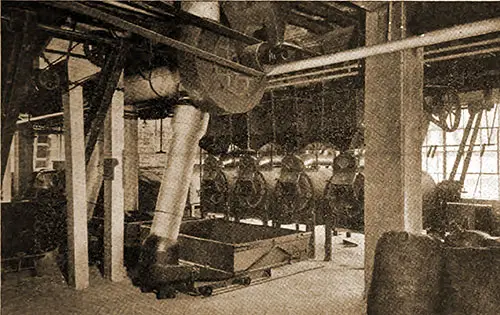 Part of the Modern Plant of Park & Tilford, New York, Which Is Completely Equipped With Burns' Cocoa-Cleaning and Roasting Apparatus. Each of the Four No. 5 Roasters Shown Is Self-Contained, and Has a Capacity of 400 To 450 Pounds per Roast. Burns Equipment Is Almost Universally Used by Manufacturing Con Fectioners and the Cocoa and Chocolate Trade Throughout the Country, Be Cause It Is Highly Efficient—Is Simple To Operate—Is Economical of Fuel— and Thoroughly Substantial Apparatus. The Spice Mill, July 1921. GGA Image ID # 163535c9e0
Part of the Modern Plant of Park & Tilford, New York, Which Is Completely Equipped With Burns' Cocoa-Cleaning and Roasting Apparatus. Each of the Four No. 5 Roasters Shown Is Self-Contained, and Has a Capacity of 400 To 450 Pounds per Roast. Burns Equipment Is Almost Universally Used by Manufacturing Con Fectioners and the Cocoa and Chocolate Trade Throughout the Country, Be Cause It Is Highly Efficient—Is Simple To Operate—Is Economical of Fuel— and Thoroughly Substantial Apparatus. The Spice Mill, July 1921. GGA Image ID # 163535c9e0
And it is easy to see how much larger the personal problem becomes when, for instance, a four-bag roast of fine coffee reaches the critical stage of its development in one of the big, new gas-fuel machines.
Large roasts are highly desirable for the factory wishing to turn out a good deal of one kind of coffee per day. As each roast means a separate decision on the part of the operator, each expert decision on big batches means just so much more work correctly done.
But the point is that in work involving unfailingly correct decisions on large batches of coffee, there is an element of greater responsibility for the operator. Assuming this enlarged responsibility is easy for men of a certain type, it is difficult for others.
It seems evident that the roasterman’s personality must always be a matter of prime importance in a coffee roasting plant, first as to his knowing how to roast coffee well and, then, as to his being in fit condition to roast as well as he knows how.
It seems proper to assume that it is really something of an art to roast a batch of coffee to develop all its cup-value possibilities fully.
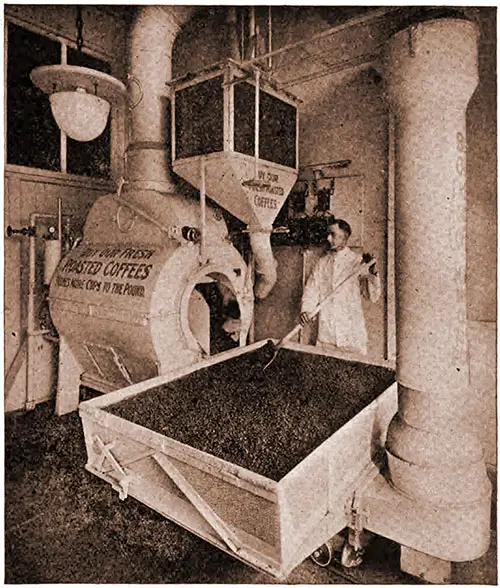
Burns No. 14 Roaster with Tiplex Cooler Box Installed in the Window of Lafer Bros. The Spice Mill, October 1921. GGA Image ID # 16359a9392
Raising the roasterman's salary could not make him know any more about coffee, but willingness to pay higher wages might secure a man who would be worth far more to the employer than the additional wage.
Salary may have less to do with the problem, however, than a reasonable appreciation of work well done. Many a roaster man is spoiled by complaints which come in from salesmen and customers which have nothing to do with the real merits of the roasted coffee the man has turned out.
His work should be judged by a competent manager who shields him from unwarranted blame and sees that he gets full credit for correct performance.
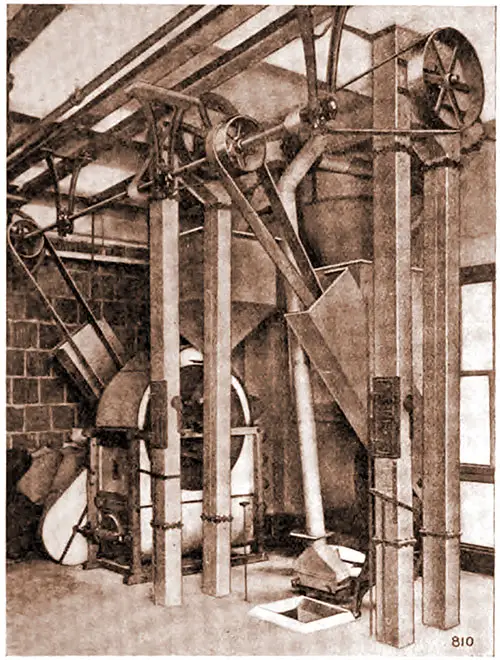
Coffee Roasting Equipment. The Spice Mill, February 1921. GGA Image ID # 1635a8680b
The difficulty in correctly judging these matters is, as suggested at the beginning, that the real cup value of coffee is a fascinatingly elusive sort of thing. Consumers are always erratic, salesmen are often selfish, and even the supposed coffee experts frequently fail to agree.
Complaints are a necessary feature of the coffee business, and they are serious only when someone is blamed unfairly. If it is the roasterman who really deserves the blame a more competent man should replace him.
If, however, he is the best available person for the job, he should be treated so well, both in wages and genuine respect, that he will be able to maintain or, even, improve on, his best previous work; and the establishment will then be sure of turning out goods of full value.
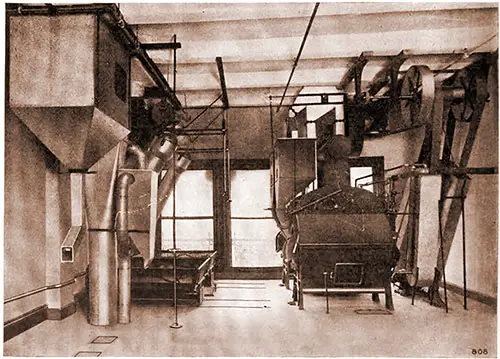
The New Acker, Merrall & Condit Co. Roasting Plant. The Spice Mill, February 1921. GGA Image ID # 1635cace02
"Is It Easy to Roast Coffee Properly? - The Importance of the Roasterman's Personality in a Coffee Roasting Plant," in The Spice Mill: Devoted to the Interests of the Coffee Tea & Spice Trades, New York: The Spice Mill Publishing Company, Vol. XLIV, No. 4, April 1921, p. 580+.
